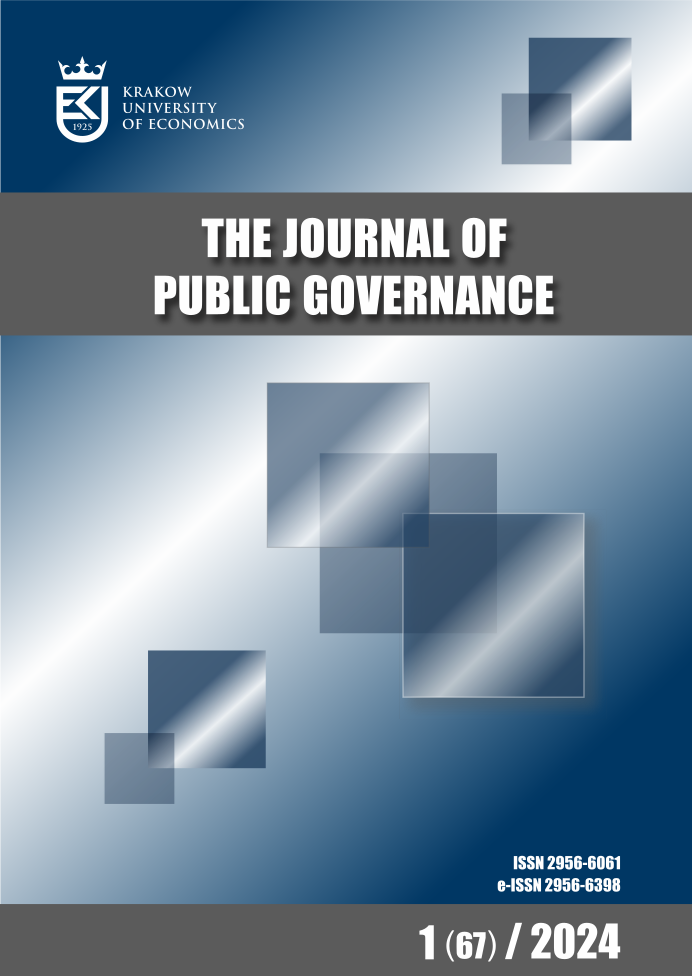A Review of Research into the Phenomenon of Fraud and Abuse in the Modern Economy: The Scale of the Problem and the Prospects for Counteracting
DOI:
https://doi.org/10.15678/PG.2022.59.1.02Keywords:
anti-fraud mechanism, fraud, briberyAbstract
Objective: The phenomenon of fraud and abuse is currently one of the greatest threats to the effective functioning of organisations. The purpose of this article is to assess the scale of the fraud phenomenon, taking into account the main types of fraud and their perpetrators. The paper also presents the anti-fraud mechanism used by organisations to reduce the risk of fraud and abuse over the past years. Based on the results of the study, conclusions have been formulated.
Research Design & Methods: This article uses a combination of quantitative and qualitative methods to describe the development of the phenomenon of fraud and abuse.
Findings: The analysis undertaken in the article showed that among anti-fraud controls, the whistleblowing tool has the highest effectiveness. In contrast, among the perpetrators of fraud, the highest percentage is taken by the employees of the organisation. The study also showed the progress of companies in implementing anti-fraud mechanisms when compared to previous years. However, it is still not sufficient enough to effectively reduce the rate of growth of committed fraud and abuse.
Implications / Recommendations: The discussion undertaken in the publication around the development of fraud and abuse indicated that the implementation of appropriate control mechanisms is essential to reduce this phenomenon. Technological advances are giving fraudsters much greater opportunities, which means that anti-fraud mechanisms will prove insufficient in the long run. It is, therefore, necessary to better adjust anti-fraud control mechanisms to the organisational structure as well as its level of culture and ethical maturity. This should be accompanied by legal initiatives at the national and international level, such as sanctioning mandatory reporting in this regard by entities.
Contribution / Value Added: The phenomenon of fraud and abuse is a significant problem for the development of organisations. Meanwhile, the controls to reduce it are still insufficient. Organisations should put much more emphasis not only on implementing anti-fraud controls, but also on monitoring their effectiveness. Legal support aimed at creating tighter anti-fraud systems is also necessary.
Downloads
References
ACFE (2022a). Occupational fraud 2002–2022: A Report to the Nations, Report to the Nations Archive (acfe.com).
ACFE (2022b). “How is occupational fraud committed?” Occupational Fraud 2022: A Report to the Nation (acfe.com).
Anand, V., Tina Dacin, M. & Murphy, P. R. (2015). The Continued Need for Diversity in Fraud Research. J Bus Ethics, 131, 751–755, https://doi.org/10.1007/s10551-014-2494-z
Bales, K., & Fox, T. (2011). Evaluating a trend analysis of fraud factors. Journal of Finance and Accountancy, 5, 1–10.
Benson, M. L., & Simpson, S. (2009). White Collar Crime: An Opportunity Perspective (1st edition). Routledge. https://doi.org/10.4324/9780203880432
Bugdol, M. (2007). Gry i zachowania nieetyczne w organizacji. Difin.
Dewi, R. (2017). The effect of internal control and anti-fraud awareness on fraud prevention (A survey on inter-governmental organizations). Journal of Economics Business and Accountancy Ventura, 20(1), 113–124. doi:10.14414/jebav.v20i1.751
Douglas, J. E., & Douglas, L. K. (2006). Modus ope randi and the signature aspects of violent crime. In J. E. Douglas, A. W. Burgess, A. G. Burgess, & R. K. Ressler (Eds.), Crime classification manual: A standard system of investigating and classifying violent crimes (pp. 19–30). Jossey-Bass/Wiley.
Erbuga, G., S. (2020). Rationality in decision-making and deterring corporate fraud. Contemporary Studies in Economic and Financial Analysis, 102, 99–110.https://doi.org/10.1108/S1569-375920200000102010
EY Poland (2020). Badanie nadużyć w sektorze finansowym 2020. Związek Przedsiębiorstw Finansowych. Available at: https://assets.ey.com/content/dam/ey-sites/ey-com/pl_pl/news/2020/10/ey-raportnaduzycia-2020.pdf (accessed: 04.08.2022).
Free, C. (2015), Looking through the fraud triangle: a review and call for new directions. Meditari Accountancy Research, 23(2), 175–196, https://doi.org/10.1108/MEDAR-02-2015-0009
Homer, E. M. (2020). Testing the fraud triangle: A systematic review. Journal of Financial Crime, 27(1), 172–187. https://doi.org/10.1108/JFC-12-2018-0136
Jalil, F. Y. (2018). Internal Control, Anti-Fraud Awareness, and Prevention of Fraud. Etikonomi: Jurnal Ekonomi, 17(2), 297–306. doi: http//dx.doi.org/10.15408/etk.v17i2.7473
Kutera, M. (2008). Rola audytu finansowego w wykrywaniu przestępstw gospodarczych. Centrum Doradztwa i Informacji Difin.
Norman, C., Rose, A., & Rose, J. (2010). Internal audit reporting lines, fraud risk decomposition, and assessments of fraud risk. Accounting, Organizations and Society, 35, 546–557.
Pfister, J. (2009). Managing Organizational Culture for Effective Internal Control: From Practice to Theory. The Accounting Review, 86(2), 738–741. doi:10.2308/accr.00000026
PwC (2022). PwC’s Global Economic Crime and Fraud Survey 2022. Protecting the perimeter: The rise of eternal fraud, Protecting the perimeter: The rise of external fraud (PwC’s Global Economic Crime and Fraud Survey 2022).
Rustiarini, N. W., Nurkholis, N., & Andayani, W. (2019). Why people commit public procurement fraud? The fraud diamond view. Journal of Public Procurement, 19(4), 345–362. https://doi.org/10.1108/JOPP-02-2019-0012
Sadgali, I., Saek, N., & Benabbou, F., (2019). Performance of machine learning techniques in the detection of financial frauds. Procedia Computer Science, 148, 45–54. https://doi.org/10.1016/j.procs.2019.01.007
Saluja, S., Aggarwal, A., & Mittal. A. (2022). Under standing the fraud theories and advancing with integrity model. Journal of Financial Crime, 29(4), 1318–1328. https://doi.org/10.1108/JFC-07-2021-0163
Sandhu N. (2022). Red flag behaviors in financial services frauds: a mixed-methods study”. Journal of Financial Regulation and Compliance, 30(2), 167–195. https://doi.org/10.1108/JFRC-01-2021-0005
Scheaf, D. J., & Wood, M. S. (2022). Entrepreneurial fraud: A multidisciplinary review and synthesized framework. Entrepreneurship Theory and Practice, 46(3), 607–642. https://doi.org/10.1177/10422587211001818
Simpson, S. S. (2019). Reimagining Sutherland 80 years after white-collar crime, Criminology, vol. 57, p.189–207. https://doi.org/10.1111/1745-9125.12206
Surdykowska, S. T. (2012). Ryzyko finansowe w środowisku globalnej gospodarki. Difin.
Sutherland, E. H. (1949). White Collar Crime. Dryden Press.
Trompeter, G. M., Carpenter, T. D., Desai, N., Jones, K. L, & Riley, R. A., Jr. (2013). A Synthesis of Fraud-Related Research. AUDITING: A Journal of Practice & Theory, 32(1), 287–321. https://doi.org/10.2308/ajpt-50360
van Onna, H. R., van der Geest, V. R., Huisman, W., & Denkers, A. J. M. (2014). Criminal trajectories in white-collar offenders. Journal of Research in Crime and Delinquency, 51, 759–784.
Wells, J. (2007). Corporate fraud handbook: Prevention and detection. John Wiley & Sons Inc.
Związek Przedsiębiorstw Finansowych w Polsce (ZPF) (2022). Nadużycia w sektorze finansowym, Raport z badania, Raport z nadużyć finansowych, Nadużycia w sektorze finansowym – ZPF.



